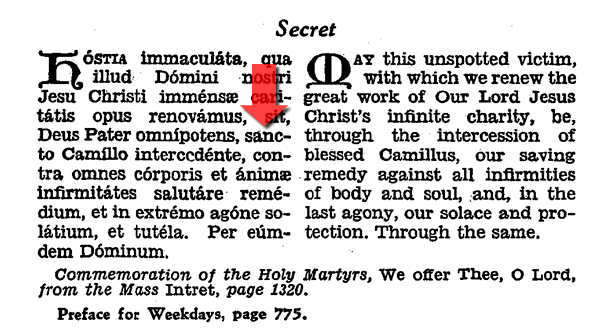Has anyone else noticed that syllabification in Latin differs SPOKEN vs. SUNG ?
-
Friends,
I would like to know WHO ELSE has noticed that Latin syllables are divided differently when SUNG than when SPOKEN.
For instance, if you look at the way the syllables are divided when WRITTEN (as in the Fr. Lasance Missal), it is done one way:
óm- ni- bus
sanc- tó- rum
sanc- tæ
(You can see this when words are hyphenated at the end of the lines.)
However, when set musically, the same word is divided differently:
ó- mni- bus
san- ctó- rum
san- ctæ
I assume this was done to help keep open vowels OPEN when sung. I'd be grateful for further thoughts and observations.
---
---
-
Hmm, interesting. A while back I was writing a piece of software to syllabify Latin and Spanish. The rules I used for Latin were (from Collins, "A Primer on Ecclesiastical Latin"):
* Divisions occur when:
* 1. After open vowels (those not followed by a consonant) (e.g., "pi-us" and "De-us"
* 2. After vowels followed by a single consonant (e.g., "vi-ta" and "ho-ra"
* 3. After the first consonant when two or more consonants follow a vowel
* (e.g., "mis-sa", "minis-ter", and "san-ctus".
*
* Exceptions:
* 1. In compound words the consonants stay together (e.g., "de-scribo").
* 2. A mute consonant (b, c, d, g, p, t) or f followed by a liquid consonant (l, r)
* go with the succeeding vowel: "la-crima", "pa-tris"
These rules seem to apply to the second style you reference (except for omnibus...). I'm not sure where the rules might come from to explain the first examples though...?
In any event, no, I never noticed it before! -
It's my experience that the difference has to do with choral precision (and yes, keeping the vowel open). IOW, it's a choral technique, not more, not less.
-
Singers deal with this when singing in lots of languages.
Singing a text is basically speaking a text in slow motion with pitches moving up and down. In this slower unfolding of speech, pitch and tone are carried on the vowel, or voiced consonants. The singer has to sing from vowel to vowel (and liquescents on voiced consonants) and move most consonants to the next syllable. -
In my experience, you're exactly right, and it IS intentional.
When I've written Latin chants, I usually move the consonants over to the next syllable, as a visual cue that the vowel is to be as long as possible. I describe to the schola that "the vowels make it music, the consonants make it words." Especially with consonants such as R or M or N, it's entirely possible to make those way too long. And "firrrrrrrma" sounds totally different than "fiiiiiiiiiiiirma." -
Carl
I have them flip the r and they don't have a chance to sing the car engine sound. -
Yeah, that was a bad example. But any cues we can use to help our struggling schola members are good!
-
I don't think it's a bad example. In my experience, even when R's are flipped, they tend to color the preceding vowel if the singers don't take care.
-
Think of singing like a Southuhnuh might tawk.
Another exception in Fr. Spencer's list:
* Unless split because of a compound (rare), the consonant pair "st" goes with the following syllable:
as in: "my-sterium" "fe-sto" "pa-stores" "gu-stibus" etc. -
A book from 1888 I own says the following on hyphenating Latin (translated from German):
The words are divided as follows: If there is a single consonant between two vowels, it belongs to the next syllable, e.g. ma-ter; two consonants between two vowels also belong to the next syllable, if they can begin a latin or greek word or are at least muta cum liquida, e.g. pa-tris, li-bri, si-gnum, scri-ptor, scri-psi, re-ctor, La-tmus, Le-sbos, po-sco, ho-spes, magi-ster, Ara-chne, te-gmen, Da-phne, Pha-tnae, rhy-thmus, else the first belongs to the preceding syllable: men-tes, fal-lo, fal-ce, al-ter, com-ma; three consonants between two vowels belong to the following syllable only if the first is c, p or s, followed by muta cum liquida, e.g. do-ctrina, Ba-ctra, corru-ptrix, sce-ptrum, ca-stra, magi-stri; four consonants between two vowels never belong to the following syllable, but at least the first belongs to the first syllable in every case, e.g. mon-strum, mul-ctrum, ton-strix. If words are composites, they are divided so that, if both components are complete, the syllables belonging to them are also left intact, e.g. abs-condo, dis-quiro, et-iam, obs-curus, red-eo, sed-itio; if both components are merged through the corruption of the first one they are divided as if they were simple [non-compound] words, e.g. de-cennis, po-tes, qua-drangu-lus, ve-neo, ani-madverto, ma-gnanimus, lon-gaevus. If in the process of division a single letter would begin or end the line, e.g. o-mnis, ante-a, the division is left out.Thanked by 1CHGiffen
Welcome to the MusicaSacra Forum!
To participate in the discussions on Catholic church music, sign in or register as a forum member, The forum is a project of the Church Music Association of America.
Categories
- All Discussions21,134
- General Music Discussion8,226
- Job Openings200
- Management of Music Programs850
- Choral Matters533
- Church Documents and Rubrics524
- CMAA Notes302
- Events718
- For Newcomers: Read First26
- Sacred Polyphony547
- Hymnody872
- Gregorian Chant: General2,701
- ↳ Graduale Romanum and Liber Usualis368
- ↳ Graduale Simplex60
- ↳ Semiology63
- Vernacular Plainsong696
- Anglican Use and Anglican Chant68
- Organ, Other Instruments and Repertoire435
- New Composition/Works in Progress1,293
- Recordings234
- Music for Hispanic Ministry159
- Music Education: Children211
- Music Education: General222
- News Items245
- Positions Wanted2
- General Discussion: Catholicism739
- Amusements177
- General Discussion1,035
- Opinions119




